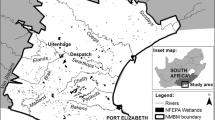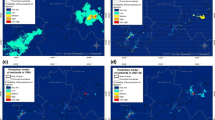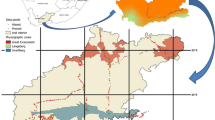Abstract
An existing non-spatial model for the prediction of response of wetland plant species on ecological factors has been transformed into a GIS-based prediction model which produces spatial output at the landscape scale. The input, spatial patterns of the ecological factors, were constructed with geostatistical spatial interpolation (kriging). With this GIS-based model the spatial patterns of presence and absence of 78 wetland plant species are predicted for an area with wetlands in the Netherlands of approximately 500 square kilometers. The GIS-based model has been validated, and the estimated uncertainty of the input has been propagated through the model. At the species level the output shows spatially coherent and non-random patterns. The validation is affected by the propagation of input errors through the model. The number of valid predictions declines approximately 10–20% when 95% confidence intervals are used in the validation. This study shows that it is feasible to use a geostatistical interpolation method to construct spatial patterns of ecological factors on a landscape scale and to use these patterns as input for a GIS-based prediction model. The added uncertainty on the input values however, affects the number of valid predictions of the model.
Similar content being viewed by others
References
Anderson, M. P. and Woesner, W. W. 1992. Applied Groundwater Modeling. Academic Press, Inc, San Diego.
Appelo, C. A. J. and Postma, D. 1993. Geochemistry, Groundwater and Pollution. Balkema, Rotterdam, Netherlands.
Austin, M. P., Nicholls, A. O., Doherty, M. D., and Meyers, J. A. 1994. Determining species response functions to an environmantal gradient by means of a Beta-function. J. Veg. Sci. 5: 215–228.
Barendregt, A. and Wassen, M. J. 1989. Het hydro-ecologisch model ICHORS (versie 2.0 en 3.0) (in Dutch, with English summary). Department of Environmental Studies, Utrecht.
Barendregt, A. and Bootsma, M. C. 1991. Het hydro-ecologisch model ICHORS (versies 3.1 en 3.2) (in Dutch, with English summary). Department of Environmental Studies, Utrecht.
Barendregt, A. 1993. Hydro-ecology of the Dutch polder landscape. Ph.D. Dissertation. Faculteit Ruimtelijke Wetenschappen, Utrecht.
Barendregt, A., Wassen, M. J., and De Smidt, J. T. 1993. Hydroecological modelling in a polder landscape: a tool for wetland management. In: Landscape ecology of a stressed environment. Edited by Vos, C. C. and Opdam, P. Pp. 79–99, Chapman and Hall, London.
Barendregt, A., Wassen, M. J., and Schot, P. P. 1995. Hydrological systems beyond a nature reserve, the major problem in wetland conservation of the Naardermeer (The Netherlands). Biol. Cons. 72: 393–405.
Bellehumeur, C., Legendre, P., and Marcotte, D. 1997. Variance and spatial scales in a tropical rainforest: changing the size sampling units. Plant Ecol. 130: 89–98.
Burrough, P. A. and McDonnell, R. A. 1998. Principles of Geographical Information Systems. Oxford University Press, Oxford.
De Mars, H. 1996. Chemical and physical dynamics of fen hydroecology. Ph.D. Dissertation. Faculteit Ruimtelijke Wetenschappen, Utrecht.
De Mars, H. and Garritsen, A. C. 1997. Interrelationship between water quality and groundwater flow dynamics in a small wetland system along a sandy hill ridge. Hydrol. Processes 11: 353–351.
Deutsch, C. V. and Journel, A. G. 1992. GSLIB: Geostatistical software library and user's guide. Oxford University Press, New York.
Environmental Protection Agency. 1991. MT3D, A modular three-dimensional transport model. User manual. S. S. Papadoupalos and Associates, Inc.
Everts, F. H. and de Vries, N. P. J. 1991. De vegetatie ontwikkeling van beekdalsystemen. Een landschapsecologische studie van enkele Drentse beekdalen (in Dutch, with English summary). Historische Uitgeverij, Groningen, The Netherlands.
Gremmen, N. J. M., Reijen, M. J. S. M, Wiertz, J., and van Wirdum, G. 1990. A model to predict and assess the effects of groundwater withdrawal on the vegetation in the pleistocene areas of the Netherlands. J. Envir. Manage. 31: 143–155.
Gross, K. L., Pregitzer, K. S., and Burton, A. J. 1995. Spatial variation in nitrogen availability in three succesional plant communities. J. Ecol. 83: 357–367.
Haines-Young, R., Green, D. R., and Cousins, S. 1993. Landscape ecology and geographic information systems. Taylor and Francis, London.
Hastie, T. J. and Tibshirani, R. J. 1990. Generalized Additive Models. Monographs on Statistics and Applied Probability 43. Chapman and Hall, London.
Heuvelink, G. B. M. 1993. Error propagation in quantitive spatial modelling. Ph.D. Dissertation. Faculteit Ruimtelijke Wetenschappen, Utrecht.
Isaaks, E. H and Srivastava, R.M. 1989. An Introduction to Applied Geostatistics. Oxford University Press, Oxford.
Istok, J. D. and Rautman, C. A. 1996. Probabilistic assesment of groundwater contaminantion: 2 Results of a case study. Ground water 34: 1050–1064.
Johnson, L. B. 1990. Analyzing spatial and temporal phenomena using geographical information systems. Landsc. Ecol. 4: 31–43.
Jongman, R. H. G., Ter Braak, C. J. F., and Van Tongeren, O. F. R. 1995. Data Analysis in Community and Landscape Ecology. Cambridge University Press. New edition with corrections.
King, A.W. 1990. Translating models across scales in the landscape. In Quantitative methods in landscape ecology. Edited by Turner, M. G. and Gardner, R. H. Pp. 479–518. Springer-Verlag, New York.
Ministry of Agriculture, Nature Management and Fisheries 1990. Nature Policy Plan of the Netherlands. The Hague, 1990.
Latour, J. B. and Reiling, R. 1993. A multiple stress model for vegetation ('move'): a tool for scenario studies and standard setting. The Science of the Total Environment (Supplement 1993): 1513–1526.
Meyers, D. E., Begovich, C. L., Butz, T. R., and Kane, V. E. 1982. Variogram models for regional groundwater geochemical data. Math. Geol. 14: 629–644.
Olde Venterink, H. and Wassen, M. J. 1997. A comparison of six models predicting vegetation response to hydrological habitat change. Ecol. Modelling 101: 347–361.
Olff, H., Berendse, F., Verkaar, D., and van Wirdum, G. 1995. Modellering van vegetatiesuccessie (in Dutch with English summary). Landschap 5: 69–82.
Pebesma, E. J. and de Kwaadsteniet, J. W. 1997. Mapping groundwater quality in the Netherlands. J. Hydrol. 200: 364–386.
Pereira, J. M. C. and Itami, R. M. 1991. Gis-based habitat modeling using logistic multiple regression: a study of Mt. Graham red squirrel. Photogr. Eng. Remote Sensing 57: 1475–1486.
Rautman, C. A. and Istok, J. D. 1996. Probabilistic assesment of groundwater contaminantion: 1 Geostatistical framework. Ground water 34: 899–909.
Ripley, B. D. 1987. Stochastic simulation. John Wiley and Sons, New York.
Robertson, G. P., Huston, M. A., Evans, F. C., and Tiede, J.M. 1988. Spatial variability in a successional plant community: patterns of nitrogen availlability. Ecology 69: 1517–1524.
Rossi, R. E., Mulla, D. J., Journel, A. G., and Franz, E. H. 1992. Geostatistics as a tool for modeling and interpreting ecological spatial dependence. Ecol. Monogr. 62: 277–314.
Runhaar, J., van Gool, C. R., and Groen, C. L. G. 1996. Impact of hydrological changes on nature conservation areas in the Netherlands. Biol. Cons. 76: 269–276.
Schot, P. P., Barendregt, A., and Wassen, M. J. 1988. Hydrology of the wetland Naardermeer: Influence of the surrounding area and impact on vegetation. Agric. Water Manage. 14: 459–470.
Schot, P. P. 1989. Grondwatersystemen en grondwaterkwaliteit in het Gooi en randgebieden (in Dutch). Interfaculteit Vakgroep Milieukunde, Utrecht.
Schot, P. P. 1991. Solute transport by groundwater flow to wetland ecosystems. Ph.D. Dissertation. Faculteit Ruimtelijke Wetenschappen, Utrecht.
Turner, M. G. 1989. Landscape ecology: The effect of pattern on process. Ann. Rev. Ecol. Syst. 20: 171–197.
Van Brussel, J., Pomarius, H., and Vergroesen, T. 1997. Horstermeerpolder onder water? Natuurontwikkeling en bestrijding van verdroging in het Noord-Hollandse Vechtplassen gebied (in Dutch, with English summary). Landschap 14: 19–32.
Van de Rijt, C. W. C. J., Hazelhoff L., and Blom, C. P. W. M. 1996. Vegetation zonation in a former tidal area: A vegetation-type response model based on DCA and logistic regression using GIS. J. Veg. Sci. 7: 505–518.
Van Den Berg, W. J. and De Smidt, J. T. 1985. De vegetatie van het oostelijk Vechtplassengebied 1935–1980 (in Dutch). Stichting Commissie voor de Vecht en het Oostelijke en Westelijk plassengebied.
Verhoeven, J. T. A. (ed.). 1992. Fens and bogs in the Netherlands. Vegetation, history, nutrient dynamics and conservation. Geobotany 18. Kluwer Academic Publishers, Dordrecht, The Netherlands.
Villard, M. and Maurer, B. A. 1996. Geostatistics as a tool for examining hypothesized declines in migratory songbirds. Ecology 77: 59–68.
Vos, C. C. and Opdam, P. (red.) 1993. Landscape ecology of a stressed environment. Chapman and Hall, London.
Wassen, M. 1990. Water flow as a major landscape ecological factor in fen development. Ph.D. Dissertation. Faculteit Ruimtelijke Wetenschappen, Utrecht.
Wassen, M. J., Barendregt, A., Schot, P. P., and Beltman, B. 1990. Dependency of local mesotrophic fens on a regional groudwater flow system in a poldered river plain in The Netherlands. Landsc. Ecol. 1: 21–38.
Wassen, M. and Schot, P. P. 1992. Hydro-ecologische modellen (in Dutch, with English summary). Landschap 9: 83–105.
Wassen, M. J. and Joosten, J. H. J. 1996. In search of a hydrological explanation for vergetation changes along a fen gradient in the Biebrza Upper Barin(Poland). Vegetatio 124: 191–209.
Wassen, M. J., van Diggelen, R., Wolejko, L., and Verhoeven, J. T. A. 1996. A comparison of fens in natural and artificial landscapes. Vegetatio 126: 5–26.
Witmer, M. C. H. 1989. Integral water management at regional level. Ph.D. Dissertation. Faculteit Ruimtelijke Wetenschappen, Utrecht.
Witte, J. P. M., Klijn, F., Claessen, F. A. M., Groen, G. L. G., and van der Meijden, R. 1992. A model to predict and asses the impact of hydrologic changes on terrestrial ecosystems in the Netherlands, and its use in a climatic scenario. Wetlands Ecol. Manage. 2: 69–83.
Author information
Authors and Affiliations
Rights and permissions
About this article
Cite this article
van Horssen, P.W., Schot, P.P. & Barendregt, A. A GIS-based plant prediction model for wetland ecosystems. Landscape Ecology 14, 253–265 (1999). https://doi.org/10.1023/A:1008058413152
Issue Date:
DOI: https://doi.org/10.1023/A:1008058413152




